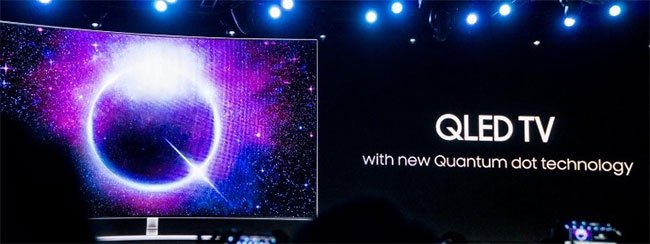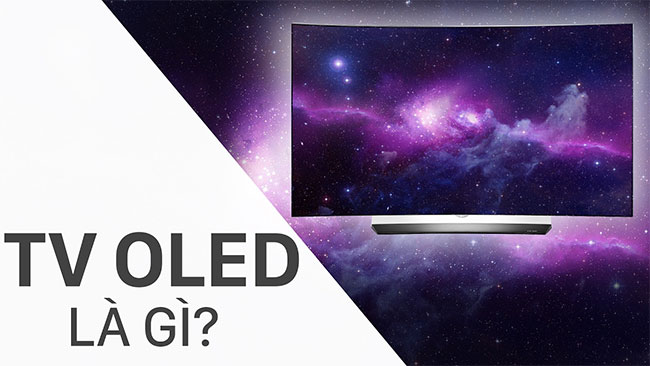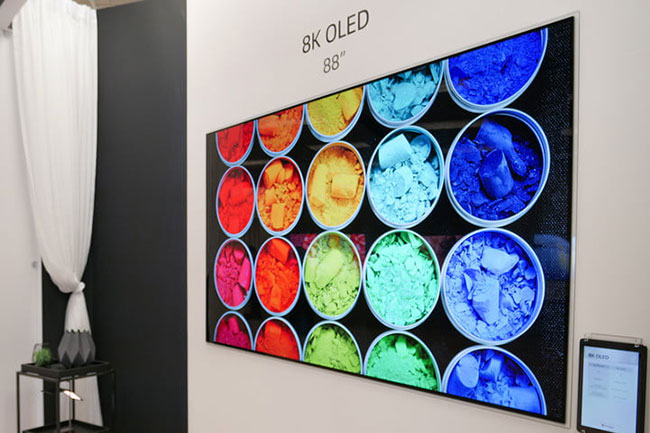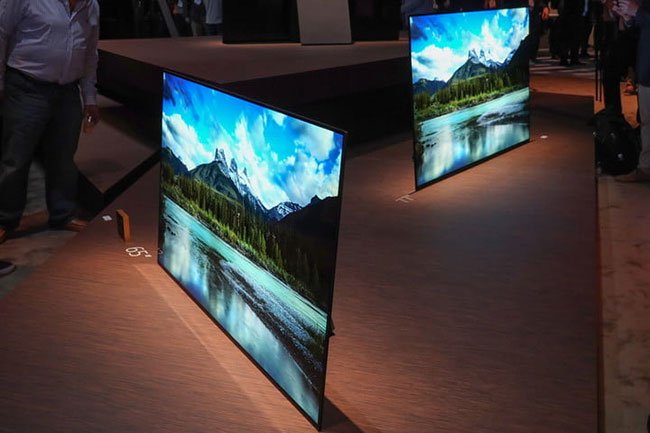Difference between QLED and OLED TV
If you're shopping for 4K TVs in a more advanced market, you might come across two terms that sound similar: QLED and OLED. Put simply, these are TV technologies that use different techniques to create the best picture fidelity you can find in a consumer product. If you remember the battle between LCD and Plasma, it would be similar to the current relationship between QLED and OLED. The difference is that they can work in harmony, not compete in a mutual destructive fashion.
Although these two concepts share the same three letters, don't be mistaken. QLED and OLED are very different technologies, each with their own strengths and weaknesses. Both apply to some of the best TVs on the market. The article will quickly present the meaning of each term and then compare the technologies to help you find the one that best suits your specific needs.
Is QLED or OLED TV a better option?
- What is QLED?
- What is OLED?
- Compare QLED and OLED
- Black levels and contrast
- Brightness
- Color space
- Response time, input delay, and refresh rate
- View
- Size
- Longevity
- Screen burn-in (save screen images)
- The energy consumption
- Price
- Final conclusion
What is QLED?

QLED stands for Quantum Light-Emitting Diode. That means the QLED TV is the same as a regular LED TV, except that it uses quantum dots embedded in the LCD panel - these tiny nanoparticles significantly improve color and brightness when compared. with non quantum LED. The technology was initially introduced to consumer TVs by Samsung, but thanks to licensing cooperation, other manufacturers are now using it.
The most important thing to know about QLED TVs is that it uses quantum dots to create light that catches your eye. That light comes from a series of LEDs located behind the LCD panel. These are the LEDs that appear in the name of the LED TV (and QLED). Some LED TVs have handy LED backlighting, even some options have thousands of lights. The article will explain why there are many better LEDs in the following section.
Before the light from these LEDs reaches your eyes, it passes through an LCD matrix - basically millions of small shutter open and close very quickly. These shutters - along with the quantum dots in the QLED TV - create the image you see by passing a moderate amount of light through and filtering it to produce colors. It is an intelligent system, but it relies on a combination of dimming the LED backlight and using the shutter to block the rest of the light, creating true black.
You will find QLED TVs made by Samsung, Hisense, Vizio and TCL.
What is OLED?

OLED stands for Organic Light-Emitting Diode. Surprisingly, the 'Light Emitting-Diode' part of the name has nothing to do with LED backlighting, as with QLED TVs and LEDs. Instead, it refers to the fact that every pixel in an OLED TV is also a tiny LED, extremely thin and can produce both light and color in a single element. In other words, an OLED TV doesn't need a backlight because each pixel creates its own light.
There are several advantages to this design, but most agree that when used in TVs, the biggest advantage is that great black levels can be achieved. Unlike QLED TVs or LEDs that dim the backlight and block the remaining light for dark scenes, the OLED TV only needs to turn off the pixels. When the pixel is turned off, it emits no light and no color, making it as dark as when the TV is turned off. It's also much easier to create a flexible OLED screen, which is why LG has pioneered it.
Only one company currently produces OLED panels. It is LG. LG sells its own OLED TVs - some of which are considered to be the best TVs you can buy - but it also sells OLED panels to companies like Sony (that's why you'll see Sony's OLED TVs). . Although the panels themselves are identical, the image processing that Sony, LG and others do is exclusive. That is why there is a significant picture quality difference when comparing one OLED TV with another.
Compare QLED and OLED
Now that you know what all the letters in these two concepts represent and what they mean for display technology, compare QLED with OLED based on the most important categories when buying a TV. : Brightness, contrast, viewing angles and other noticeable performance considerations, such as response time and lifespan. These are all important factors when you spend up to $ 6,000 (138,000,000 VND) to own a top TV.
Black levels and contrast
Contrast is the difference between the darkest and the brightest parts of an image. If a TV can bring out the true black part, it doesn't have to make the other parts light up to achieve a good level of contrast. That's why, when it comes to black levels, OLEDs become the undisputed champion - thanks to the ability to turn completely black when needed.

In contrast, the QLED TV is forced to dim the LED backlight and block the rest of the light, which is difficult to perform perfectly.
It may cause a 'light leak'. This is the phenomenon when light floods the black part of the screen.
But is it noticeable? Sure. For example, if you're watching an intense action movie and two characters are running through the parking lot at night, you may notice a little glow on the dark parts of the scene or in the two black bars ( letterbox bar) at the top and bottom of the screen while watching movies on DVD.
In fact, it was difficult to make LED-backlit TVs so dark, TV manufacturers were forced to increase the number of LEDs used to have better control over which part of the picture. will become dark. The best black level can be reached with the QLED TV. Samsung is almost ready to start selling microLED TVs that use separate LEDs for each pixel, which in theory will provide black levels on par with OLED.
However, OLED is now the first option. If a pixel receives no electricity, it will not produce light and therefore will be completely black.
More outstanding option: OLED.
Brightness
QLED TVs have a significant advantage when it comes to brightness. Because they use separate backlighting (instead of relying on each pixel to create their own light), this LED backlight can be made extremely bright. Adding the ability of quantum dots to maximize that light by creating brighter colors in the color spectrum without losing saturation, you've got a screen that's bright enough to see clearly, even in the brightest rooms.

OLED panels cannot compete on the basis of pure brightness. Their individual glowing pixels simply cannot produce the same amount of light. In a dark room, this is practically not the case. Remember that QLED TVs need to be brighter to provide the same contrast between dark and bright areas - but in bright environments, or where there is more sunlight through the window, QLED TVs show more clearly - especially if you are playing HDR content in these conditions.
More outstanding option: QLED.
Color space
OLEDs used to be unrivaled in this regard, but the use of quantum dots in QLED TVs made for better accuracy, brightness and color volume. Samsung claims that the wider range of fine saturated colors at extremely high brightness levels is an advantage.
While there's no denying the fact that QLED TVs deliver great colors, users still find better saturated colors at high brightness levels to offer real advantages in normal viewing situations. - so for now, QLED and OLED blend together in this regard, because colors are subjective. There is a need to consider some tangible evidence in order to claim QLED as the superior option.
More outstanding option: Draw.
Response time, input delay, and refresh rate
Response time refers to the time it takes for a pixel to move from one state to another. The faster the response time, the sharper the image, especially in fast action scenes. Although it is difficult for the naked eye to discern the difference in response time, the standard OLED TV measurements are much faster than QLED TVs.
The response time on the QLED typically ranges from 2 to 8 milliseconds, which sounds pretty good until you realize that the response time of an OLED is only about 0.1 milliseconds.
On the other hand, input lag refers to the delay between performing an action (assuming a button is pressed on the gaming controller) and viewing the result of that action on the screen. As such, input lag is really only a concern for gamers - it has no outstanding effect on passive content viewing. In addition, the level of input lag you encounter is less related to display technology, but due to the image processing taking place on the TV at the back of the decision. Both QLED and OLED TVs can achieve very low input lag, if you turn off all of the additional video processing features or simply use Game Mode of the TV.
Refresh rate is another factor, often more important for gamers than regular viewers. It refers to the number of times each second the TV updates what is displayed on the screen. Under normal circumstances, the TV will use a refresh rate of 60Hz or sometimes double - 120Hz. Some games that run on consoles or PCs use what's called VRR or Variable Refresh Rate.
If your TV does not support VRR, it may cause some unwanted side effects such as screen tearing, when used with VRR games. You can find VRR models in both OLED and QLED TVs, so make sure the TV you choose has this feature, if you really need it.
- What is the difference between Refresh Rate 60Hz, 144Hz and 240Hz?
With the superior response time, OLED is the superior option in this respect.
More outstanding option: OLED.
View
With the QLED screen, the best viewing angle is the front view. Image quality decreases both in color and contrast as you move sideways or up and down. Although severity varies from model to model, they are all very noticeable. However, TV manufacturers have made every effort to eliminate this problem.

The OLED screen may not degrade brightness at different viewing angles - up to 84 degrees. Some QLED TVs have improved viewing angles with anti-reflective layers, but OLED still maintains a clear advantage in this regard. So, if you want to arrange movie nights with your family and need to make sure there are no hard seats to watch, an OLED TV is the best option.
More outstanding option: OLED.
Size
OLEDs have come a long way. When the technology was still in its infancy, the OLED screen reached a maximum size of 55 inches. Currently, 88-inch OLED screens have appeared. As mentioned, there are fewer restrictions on the size of the QLED screen (some TVs are up to 100 inches, even larger). Samsung's largest consumer model is 98 inches.
More outstanding option: QLED.
Longevity
LG says you'll have to watch OLED TV 5 hours a day for 54 years before they reduce brightness by 50%. Whether that is true is still to be considered, since OLED TVs have only been around since 2013. QLED is even newer, but its light source - LED lights - has been monitored and proven effective in a long time. For that reason, the winning option in this category is QLED.
More outstanding option (until now): QLED.
Screen burn-in (save screen images)
Despite these concerns, the fact is that this effect will not be an issue for most people - especially for those with QLED TVs because the QLED is not easily saved. On the other hand, OLED is likely to suffer from this situation (but you have to be extremely unlucky to see this phenomenon happen to your TV, even if you repeatedly have a static image on it). day and night).
The effect of saving the screen image originates from the boxed CRT TV era. When the monitor displays a still image, it will cause the image to appear 'saved' on the screen. That happens when the phosphor coatings on the back of the screen glow for a long time, causing them to wear out.
QLED TVs do not easily save screen images. The same problem can occur with QLED TVs because the glowing compounds degrade over time. If you burn a pixel strong enough and long enough, you'll soon get it blurred and have a problem with the rest of the pixels - but you'll basically have to use a TV at very high intensity to get this result.
You have to watch ESPN all day (for days in a row) at the brightest setting that can cause a problem (but even that may be okay).
In short, the potential for screen saving to occur is there and should be noted. In particular, gamers who leave the TV while still images remain on screen or play 10 hours a day for weeks are likely to cause some burn-in errors on OLED TVs. But, because the QLED TV is not easy to encounter this phenomenon, this option wins the battle, technically.
More outstanding option: QLED.
The energy consumption
The OLED panel is extremely thin and does not need a backlight. Therefore, OLED TVs are lighter and thinner than QLED TVs. They also require less energy, so are more efficient.
More outstanding option: OLED.
Price
In the past, QLED TVs were the superior option in this respect. But the price of OLED TVs has dropped and the article only mentions premium options here, so QLED TVs are priced similarly (or slightly more depending on size). Companies like TCL are beginning to reduce costs for QLED TVs.
More outstanding option: QLED
Final conclusion
Both technologies are impressive in their own way, but the article needs to pick out the more superior option, and for now, it's OLED. With a better representation of the factors most people will pay attention to when watching TV shows and movies, OLED has the best picture quality you can buy.
QLED delivers higher brightness, longer lifespan, bigger screen size and lower price. On the other hand, OLEDs have better viewing angles, deeper black levels and use less power. However, both are great, so choosing between them is subjective - the QLED is a better all-round device, but OLED excels in the dark.
The fact is that you won't regret choosing any of these options. Of course, that is until the next generation of display technology appears. Samsung said it is working on embedding its quantum dot technology into an OLED panel, in order to create the best TV that combines both of these concepts. But it may take several years for this to come true, so users will have to wait and see.
 Everything you need to know to enjoy podcasts on Apple TV
Everything you need to know to enjoy podcasts on Apple TV 7 mistakes to make when cleaning the TV screen
7 mistakes to make when cleaning the TV screen How to check the TV usage period
How to check the TV usage period How to check Samsung TV warranty period
How to check Samsung TV warranty period Harmful myths when adjusting the TV definition
Harmful myths when adjusting the TV definition What is the virtual assistant on TV, which TV streams are integrated virtual assistants?
What is the virtual assistant on TV, which TV streams are integrated virtual assistants?